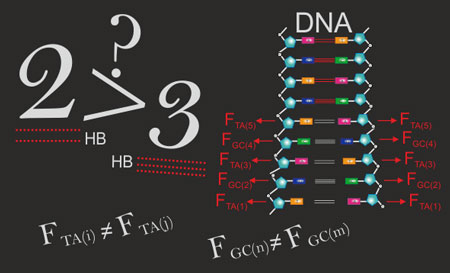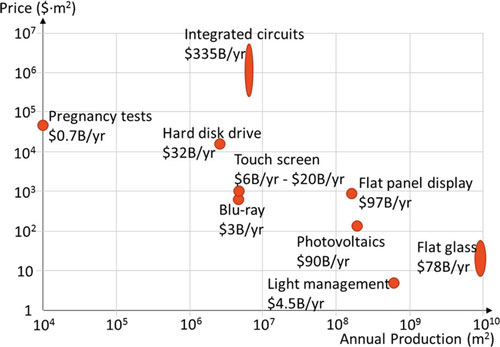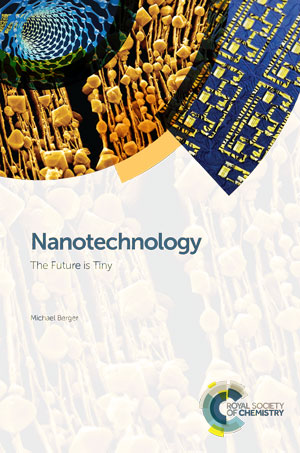i have two bits of news, one from this October 2017 about using light to control a memristor’s learning properties and one from December 2017 about memristors and neural networks.
Shining a light on the memristor
Michael Berger wrote an October 30, 2017 Nanowerk Sportlight article about some of the latest work concerning memristors and light,
Memristors – or resistive memory – are nanoelectronic devices that are very promising components for next generation memory and computing devices. They are two-terminal electric elements similar to a conventional resistor – however, the electric resistance in a memristor is dependent on the charge passing through it; which means that its conductance can be precisely modulated by charge or flux through it. Its special property is that its resistance can be programmed (resistor function) and subsequently remains stored (memory function).
In this sense, a memristor is similar to a synapse in the human brain because it exhibits the same switching characteristics, i.e. it is able, with a high level of plasticity, to modify the efficiency of signal transfer between neurons under the influence of the transfer itself. That’s why researchers are hopeful to use memristors for the fabrication of electronic synapses for neuromorphic (i.e. brain-like) computing that mimics some of the aspects of learning and computation in human brains.
Human brains may be slow at pure number crunching but they are excellent at handling fast dynamic sensory information such as image and voice recognition. Walking is something that we take for granted but this is quite challenging for robots, especially over uneven terrain.
…
“Memristors present an opportunity to make new types of computers that are different from existing von Neumann architectures, which traditional computers are based upon,” Dr Neil T. Kemp, a Lecturer in Physics at the University of Hull [UK], tells Nanowerk. “Our team at the University of Hull is focussed on making memristor devices dynamically reconfigurable and adaptive – we believe this is the route to making a new generation of artificial intelligence systems that are smarter and can exhibit complex behavior. Such systems would also have the advantage of memristors, high density integration and lower power usage, so these systems would be more lightweight, portable and not need re-charging so often – which is something really needed for robots etc.”
…
In their new paper in Nanoscale (“Reversible Optical Switching Memristors with Tunable STDP Synaptic Plasticity: A Route to Hierarchical Control in Artificial Intelligent Systems”), Kemp and his team demonstrate the ability to reversibly control the learning properties of memristors via optical means.
The reversibility is achieved by changing the polarization of light. The researchers have used this effect to demonstrate tuneable learning in a memristor. One way this is achieved is through something called Spike Timing Dependent Plasticity (STDP), which is an effect known to occur in human brains and is linked with sensory perception, spatial reasoning, language and conscious thought in the neocortex.
STDP learning is based upon differences in the arrival time of signals from two adjacent neurons. The University of Hull team has shown that they can modulate the synaptic plasticity via optical means which enables the devices to have tuneable learning.
“Our research findings are important because it demonstrates that light can be used to control the learning properties of a memristor,” Kemp points out. “We have shown that light can be used in a reversible manner to change the connection strength (or conductivity) of artificial memristor synapses and as well control their ability to forget i.e. we can dynamically change device to have short-term or long-term memory.”
…
According to the team, there are many potential applications, such as adaptive electronic circuits controllable via light, or in more complex systems, such as neuromorphic computing, the development of optically reconfigurable neural networks.
Having optically controllable memristors can also facilitate the implementation of hierarchical control in larger artificial-brain like systems, whereby some of the key processes that are carried out by biological molecules in human brains can be emulated in solid-state devices through patterning with light.
Some of these processes include synaptic pruning, conversion of short term memory to long term memory, erasing of certain memories that are no longer needed or changing the sensitivity of synapses to be more adept at learning new information.
…
“The ability to control this dynamically, both spatially and temporally, is particularly interesting since it would allow neural networks to be reconfigurable on the fly through either spatial patterning or by adjusting the intensity of the light source,” notes Kemp.
…
In their new paper in Nanoscale Currently, the devices are more suited to neuromorphic computing applications, which do not need to be as fast. Optical control of memristors opens the route to dynamically tuneable and reprogrammable synaptic circuits as well the ability (via optical patterning) to have hierarchical control in larger and more complex artificial intelligent systems.
…
“Artificial Intelligence is really starting to come on strong in many areas, especially in the areas of voice/image recognition and autonomous systems – we could even say that this is the next revolution, similarly to what the industrial revolution was to farming and production processes,” concludes Kemp. “There are many challenges to overcome though. …
That excerpt should give you the gist of Berger’s article and, for those who need more information, there’s Berger’s article and, also, a link to and a citation for the paper,
Reversible optical switching memristors with tunable STDP synaptic plasticity: a route to hierarchical control in artificial intelligent systems by Ayoub H. Jaafar, Robert J. Gray, Emanuele Verrelli, Mary O’Neill, Stephen. M. Kelly, and Neil T. Kemp. Nanoscale, 2017,9, 17091-17098 DOI: 10.1039/C7NR06138B First published on 24 Oct 2017
This paper is behind a paywall.
The memristor and the neural network
It would seem machine learning could experience a significant upgrade if the work in Wei Lu’s University of Michigan laboratory can be scaled for general use. From a December 22, 2017 news item on ScienceDaily,
A new type of neural network made with memristors can dramatically improve the efficiency of teaching machines to think like humans.
The network, called a reservoir computing system, could predict words before they are said during conversation, and help predict future outcomes based on the present.
The research team that created the reservoir computing system, led by Wei Lu, professor of electrical engineering and computer science at the University of Michigan, recently published their work in Nature Communications.
A December 19, 2017 University of Michigan news release (also on EurekAlert) by Dan Newman, which originated the news item, expands on the theme,
Reservoir computing systems, which improve on a typical neural network’s capacity and reduce the required training time, have been created in the past with larger optical components. However, the U-M group created their system using memristors, which require less space and can be integrated more easily into existing silicon-based electronics.
Memristors are a special type of resistive device that can both perform logic and store data. This contrasts with typical computer systems, where processors perform logic separate from memory modules. In this study, Lu’s team used a special memristor that memorizes events only in the near history.
Inspired by brains, neural networks are composed of neurons, or nodes, and synapses, the connections between nodes.
To train a neural network for a task, a neural network takes in a large set of questions and the answers to those questions. In this process of what’s called supervised learning, the connections between nodes are weighted more heavily or lightly to minimize the amount of error in achieving the correct answer.
Once trained, a neural network can then be tested without knowing the answer. For example, a system can process a new photo and correctly identify a human face, because it has learned the features of human faces from other photos in its training set.
“A lot of times, it takes days or months to train a network,” says Lu. “It is very expensive.”
Image recognition is also a relatively simple problem, as it doesn’t require any information apart from a static image. More complex tasks, such as speech recognition, can depend highly on context and require neural networks to have knowledge of what has just occurred, or what has just been said.
“When transcribing speech to text or translating languages, a word’s meaning and even pronunciation will differ depending on the previous syllables,” says Lu.
This requires a recurrent neural network, which incorporates loops within the network that give the network a memory effect. However, training these recurrent neural networks is especially expensive, Lu says.
Reservoir computing systems built with memristors, however, can skip most of the expensive training process and still provide the network the capability to remember. This is because the most critical component of the system – the reservoir – does not require training.
When a set of data is inputted into the reservoir, the reservoir identifies important time-related features of the data, and hands it off in a simpler format to a second network. This second network then only needs training like simpler neural networks, changing weights of the features and outputs that the first network passed on until it achieves an acceptable level of error.
IMAGE: Schematic of a reservoir computing system, showing the reservoir with internal dynamics and the simpler output. Only the simpler output needs to be trained, allowing for quicker and lower-cost training. Courtesy Wei Lu.
“The beauty of reservoir computing is that while we design it, we don’t have to train it,” says Lu.
The team proved the reservoir computing concept using a test of handwriting recognition, a common benchmark among neural networks. Numerals were broken up into rows of pixels, and fed into the computer with voltages like Morse code, with zero volts for a dark pixel and a little over one volt for a white pixel.
Using only 88 memristors as nodes to identify handwritten versions of numerals, compared to a conventional network that would require thousands of nodes for the task, the reservoir achieved 91% accuracy.
…Reservoir computing systems are especially adept at handling data that varies with time, like a stream of data or words, or a function depending on past results.
To demonstrate this, the team tested a complex function that depended on multiple past results, which is common in engineering fields. The reservoir computing system was able to model the complex function with minimal error.
Lu plans on exploring two future paths with this research: speech recognition and predictive analysis.
“We can make predictions on natural spoken language, so you don’t even have to say the full word,” explains Lu.
“We could actually predict what you plan to say next.”
In predictive analysis, Lu hopes to use the system to take in signals with noise, like static from far-off radio stations, and produce a cleaner stream of data. “It could also predict and generate an output signal even if the input stopped,” he says.
IMAGE: Wei Lu, Professor of Electrical Engineering & Computer Science at the University of Michigan holds a memristor he created. Photo: Marcin Szczepanski.
The work was published in Nature Communications in the article, “Reservoir computing using dynamic memristors for temporal information processing”, with authors Chao Du, Fuxi Cai, Mohammed Zidan, Wen Ma, Seung Hwan Lee, and Prof. Wei Lu.
The research is part of a $6.9 million DARPA [US Defense Advanced Research Projects Agency] project, called “Sparse Adaptive Local Learning for Sensing and Analytics [also known as SALLSA],” that aims to build a computer chip based on self-organizing, adaptive neural networks. The memristor networks are fabricated at Michigan’s Lurie Nanofabrication Facility.
Lu and his team previously used memristors in implementing “sparse coding,” which used a 32-by-32 array of memristors to efficiently analyze and recreate images.
Here’s a link to and a citation for the paper,
Reservoir computing using dynamic memristors for temporal information processing by Chao Du, Fuxi Cai, Mohammed A. Zidan, Wen Ma, Seung Hwan Lee & Wei D. Lu. Nature Communications 8, Article number: 2204 (2017) doi:10.1038/s41467-017-02337-y Published online: 19 December 2017
This is an open access paper.




